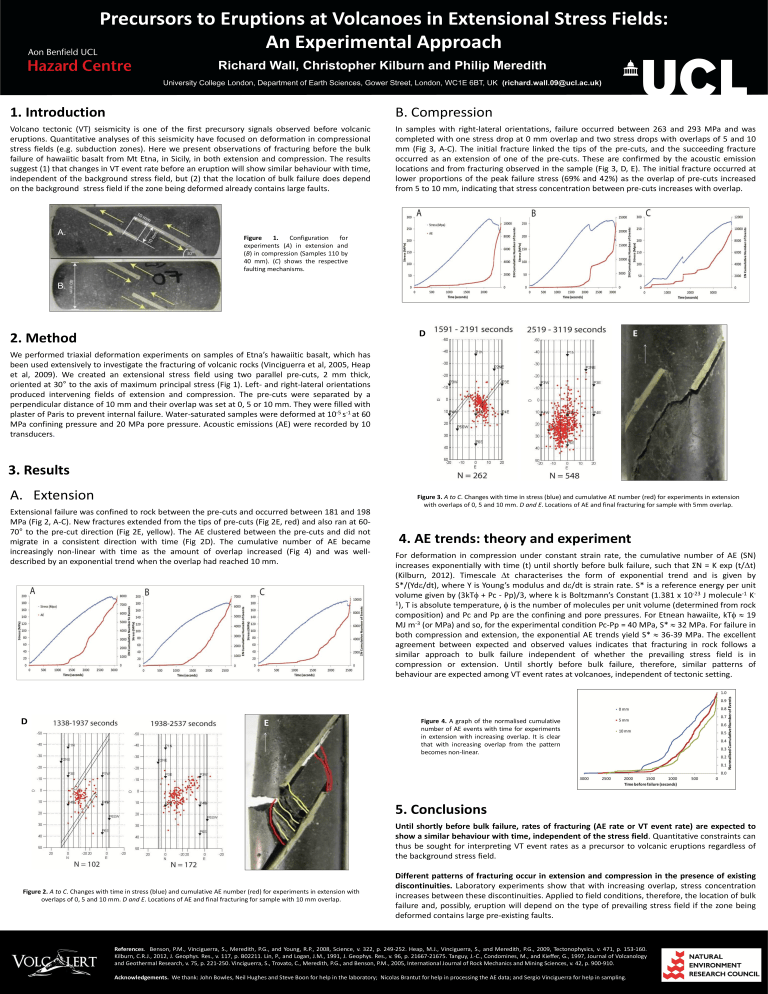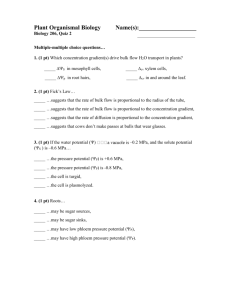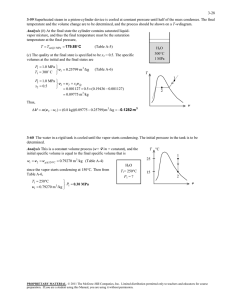Precursors to Eruptions at Volcanoes in Extensional Stress Fields: 1. Introduction

Precursors to Eruptions at Volcanoes in Extensional Stress Fields:
An Experimental Approach
Richard Wall, Christopher Kilburn and Philip Meredith
University College London, Department of Earth Sciences, Gower Street, London, WC1E 6BT, UK (richard.wall.09@ucl.ac.uk)
1. Introduction
Volcano tectonic (VT) seismicity is one of the first precursory signals observed before volcanic eruptions. Quantitative analyses of this seismicity have focused on deformation in compressional stress fields (e.g. subduction zones). Here we present observations of fracturing before the bulk failure of hawaiitic basalt from Mt Etna, in Sicily, in both extension and compression. The results suggest (1) that changes in VT event rate before an eruption will show similar behaviour with time, independent of the background stress field, but (2) that the location of bulk failure does depend on the background stress field if the zone being deformed already contains large faults.
B. Compression
In samples with right-lateral orientations, failure occurred between 263 and 293 MPa and was completed with one stress drop at 0 mm overlap and two stress drops with overlaps of 5 and 10 mm (Fig 3, A-C). The initial fracture linked the tips of the pre-cuts, and the succeeding fracture occurred as an extension of one of the pre-cuts. These are confirmed by the acoustic emission locations and from fracturing observed in the sample (Fig 3, D, E). The initial fracture occurred at lower proportions of the peak failure stress (69% and 42%) as the overlap of pre-cuts increased from 5 to 10 mm, indicating that stress concentration between pre-cuts increases with overlap.
A.
Figure 1. Configuration for experiments ( A ) in extension and
( B ) in compression (Samples 110 by
40 mm). ( C ) shows the respective faulting mechanisms.
B.
2. Method
We performed triaxial deformation experiments on samples of Etna’s hawaiitic basalt, which has been used extensively to investigate the fracturing of volcanic rocks (Vinciguerra et al, 2005, Heap et al, 2009). We created an extensional stress field using two parallel pre-cuts, 2 mm thick, oriented at 30
°
to the axis of maximum principal stress (Fig 1). Left- and right-lateral orientations produced intervening fields of extension and compression. The pre-cuts were separated by a perpendicular distance of 10 mm and their overlap was set at 0, 5 or 10 mm. They were filled with plaster of Paris to prevent internal failure. Water-saturated samples were deformed at 10 -5 s -1 at 60
MPa confining pressure and 20 MPa pore pressure. Acoustic emissions (AE) were recorded by 10 transducers .
D E
3. Results
A. Extension
Extensional failure was confined to rock between the pre-cuts and occurred between 181 and 198
MPa (Fig 2, A-C). New fractures extended from the tips of pre-cuts (Fig 2E, red) and also ran at 60-
70
°
to the pre-cut direction (Fig 2E, yellow). The AE clustered between the pre-cuts and did not migrate in a consistent direction with time (Fig 2D). The cumulative number of AE became increasingly non-linear with time as the amount of overlap increased (Fig 4) and was welldescribed by an exponential trend when the overlap had reached 10 mm.
Figure 3. A to C . Changes with time in stress (blue) and cumulative AE number (red) for experiments in extension with overlaps of 0, 5 and 10 mm. D and E . Locations of AE and final fracturing for sample with 5mm overlap.
4. AE trends: theory and experiment
For deformation in compression under constant strain rate, the cumulative number of AE (SN) increases exponentially with time (t) until shortly before bulk failure, such that ΣN = K exp (t/
t)
(Kilburn, 2012). Timescale
t characterises the form of exponential trend and is given by
S*/(Yd
/dt), where Y is Young’s modulus and d
/dt is strain rate. S* is a reference energy per unit
1 volume given by (3kT
+ Pc - Pp)/3, where k is Boltzmann’s Constant (1.381 x 10 -23 J molecule -1 K -
), T is absolute temperature,
is the number of molecules per unit volume (determined from rock composition) and Pc and Pp are the confining and pore pressures. For Etnean hawaiite, kT
19
MJ m -3 (or MPa) and so, for the experimental condition Pc-Pp = 40 MPa, S*
32 MPa. For failure in both compression and extension, the exponential AE trends yield S*
36-39 MPa. The excellent agreement between expected and observed values indicates that fracturing in rock follows a similar approach to bulk failure independent of whether the prevailing stress field is in compression or extension. Until shortly before bulk failure, therefore, similar patterns of behaviour are expected among VT event rates at volcanoes, independent of tectonic setting.
D E Figure 4. A graph of the normalised cumulative number of AE events with time for experiments in extension with increasing overlap. It is clear that with increasing overlap from the pattern becomes non-linear.
Figure 2. A to C . Changes with time in stress (blue) and cumulative AE number (red) for experiments in extension with overlaps of 0, 5 and 10 mm. D and E . Locations of AE and final fracturing for sample with 10 mm overlap.
5. Conclusions
Until shortly before bulk failure, rates of fracturing (AE rate or VT event rate) are expected to show a similar behaviour with time, independent of the stress field
. Quantitative constraints can thus be sought for interpreting VT event rates as a precursor to volcanic eruptions regardless of the background stress field.
Different patterns of fracturing occur in extension and compression in the presence of existing discontinuities.
Laboratory experiments show that with increasing overlap, stress concentration increases between these discontinuities. Applied to field conditions, therefore, the location of bulk failure and, possibly, eruption will depend on the type of prevailing stress field if the zone being deformed contains large pre-existing faults.
References . Benson, P.M., Vinciguerra, S., Meredith, P.G., and Young, R.P., 2008, Science, v. 322, p. 249-252. Heap, M.J., Vinciguerra, S., and Meredith, P.G., 2009, Tectonophysics, v. 471, p. 153-160.
Kilburn, C.R.J., 2012, J. Geophys. Res., v. 117, p. B02211. Lin, P., and Logan, J.M., 1991, J. Geophys. Res., v. 96, p. 21667-21675. Tanguy, J.-C., Condomines, M., and Kieffer, G., 1997, Journal of Volcanology and Geothermal Research, v. 75, p. 221-250. Vinciguerra, S., Trovato, C., Meredith, P.G., and Benson, P.M., 2005, International Journal of Rock Mechanics and Mining Sciences, v. 42, p. 900-910.
Acknowledgements.
We thank: John Bowles, Neil Hughes and Steve Boon for help in the laboratory; Nicolas Brantut for help in processing the AE data; and Sergio Vinciguerra for help in sampling.



